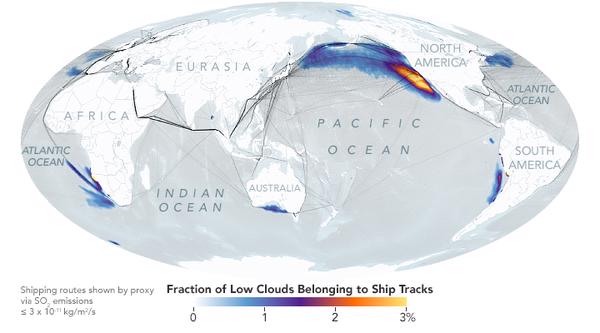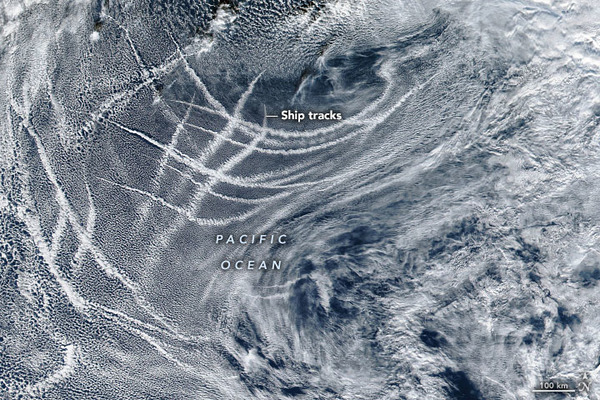NASA sees positive impacts of IMO 2020 from space
A new study by US space agency the National Aeronautics and Space Administration (NASA) shows that IMO 2020 successfully reduced the levels of “ship track” clouds in 2020.
 PHOTO: According to a new NASA study, ship tracks fell significantly in 2020, due to IMO’s new sulphur regulation. NASA Earth Observatory
PHOTO: According to a new NASA study, ship tracks fell significantly in 2020, due to IMO’s new sulphur regulation. NASA Earth Observatory
Ship tracks, which NASA calls “ghostly fingerprints,” are basically clouds that form around tiny particles (aerosols) in ship exhaust. These tiny particles are generally stretched out in long narrow paths by winds, giving the clouds their signature shape. These highly concentrated clouds disperse more light, making them appear brighter than normal clouds that form over larger particles like sea salt.
These ship tracks are residues of modern trading routes, and can be used to trace global maritime routes from the North Pacific to the Mediterranean Sea. However, satellite images have showed marked reduction in these ship tracks in 2020. That was the year the International Maritime Organisation’s (IMO) 0.50% sulphur cap came into effect.
 PHOTO: Satellite image of ship tracks. NASA Earth Observatory
PHOTO: Satellite image of ship tracks. NASA Earth Observatory
IMO 2020 changed the composition of ship exhaust, leading to smaller aerosol particles, which in turn deterred formation of ship tracks. The study saw reduction of ship tracks in every major shipping lane in 2020.
The study found that trade disruptions triggered by the Covid-19 pandemic played a small part in this effect, as it reduced global shipping traffic by 1.4% for several months. However, it concluded that the “record-low levels” of ship track should primarily be attributed to IMO 2020.
The team behind the study created a global climatology of ship tracks use artificial intelligence to collate ship tracks across 17 years (2003-20) from daytime images captured by NASA’s Moderate Resolution Imaging Spectroradiometer (MODIS) aboard the Aqua satellite.
The lead author of the study, Tianle Yuan, who is an atmospheric scientist at NASA’s Goddard Space Flight Center in Greenbelt, US, said: “Ship tracks are great natural laboratories for studying the interaction between aerosols and low clouds,” and can also be used to study climate change.
By Tuhin Roy
Please get in touch with comments or additional info to news@engine.online






